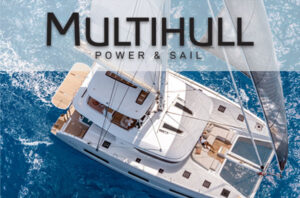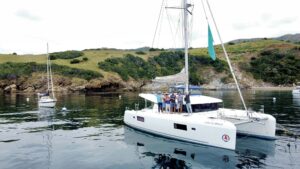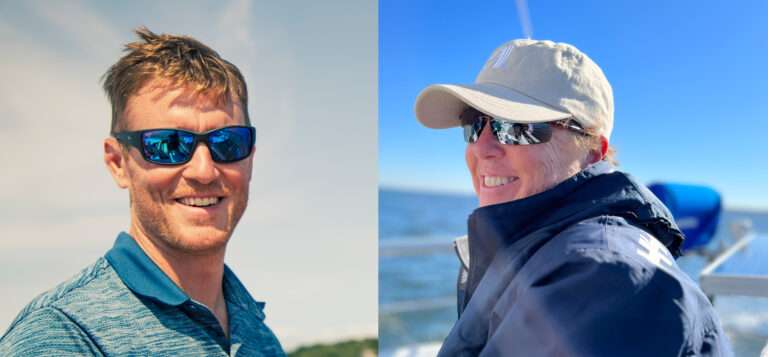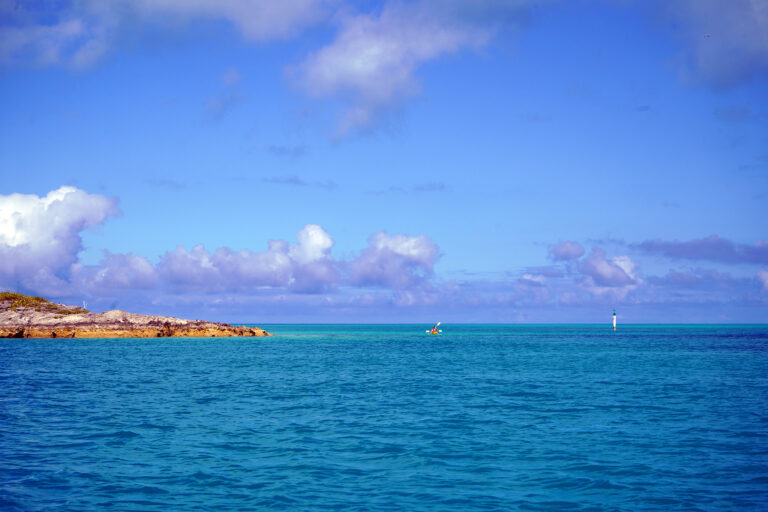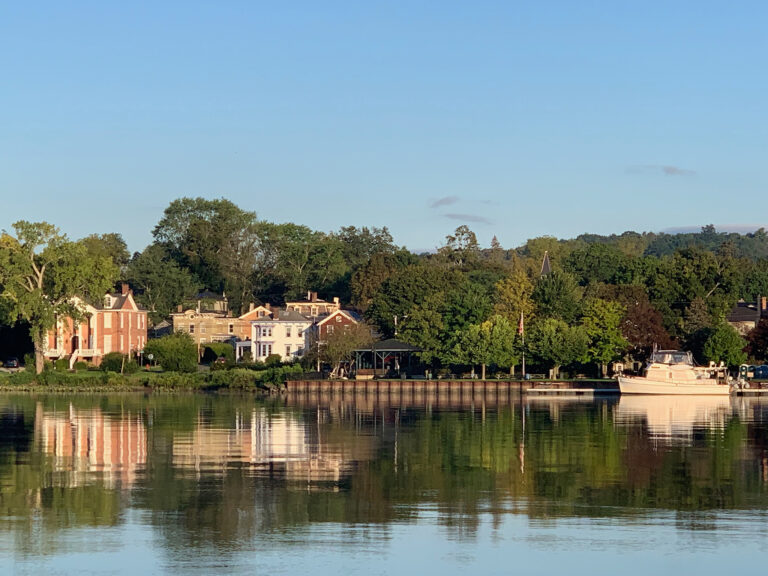“Waitpinga has circumnavigated Oz once, been to Indo three times, traversed Bass Straight several times, and is comfortable, warm and a hoot to sail. She can deal with a crowd and is sensational to handle. She can stir like a bobcat with the two motors and turn on a pinhead.”
—Capt. Aidan Glasby on his Derek Kelsall K44
Dancing with an island king, being chased by the Indonesian Navy, searching for the ever-elusive Bird of Paradise: when you’re cruising the remote Banda Sea, you can be sure you’ll come back with a rich supply of sea stories. As a freelance filmmaker in Australia, I’d long wanted to visit the Banda Sea, surrounded by the hundreds of islands that make up Indonesia’s Maluku Province. The region’s turbulent history and remoteness have always fascinated me. Two thousand years ago, nutmeg from Banda was shipped to the temples of Caesar’s Rome, and for centuries Bird of Paradise feathers from the island of Aru graced the hats of the Chinese Emperors. The British and Dutch fought bitter and bloody wars over the Spice Islands, a part of history that is now all but forgotten.
So, back in 2001, when my old friend Ben Brooks called to tell me about Aidan Glasby, a 21-year-old skipper-for-hire who was sailing his homebuilt 10-berth catamaran, Waitpinga, to Darwin in Australia’s northern Territory, and that he might be persuaded to take us to Indonesia, I phoned Aidan at once. “When do we leave?” he replied—and so the adventure began.
Aidan was sailing up the Western Australian coast with his sister Ays and best mates Ollie and Zeshi, and would soon arrive in Darwin, Australia’s ancient front door. He had built Waitpinga, a Derek Kelsall K44 catamaran, while still in high school in the Adelaide Hills in South Australia. She is 44 feet long with a 23-foot beam; constructed of plywood above the waterline and strip-planked cedar below with a round bilge; and is sheathed in fiberglass inside and out. Her cruising speed is 8-10 knots, and she carries twin auxiliary 25hp outboard motors. She looked like an ideal platform for what we had in mind.
We hastily put together a semi-professional film crew and hired Aidan to sail us into Indonesian waters for eight weeks to shoot a documentary, to be titled Spice Islands Adventure. Our crew of 10 met in Darwin in July, and with Indonesian visas in our passports and food, water, charts and fuel stowed away, we were ready to sail.
[advertisement]
As the lights of Darwin disappeared astern we felt a surge of excitement. A gentle southeasterly breeze saw us sailing at 6 knots into the Tiwi Islands at dawn, to drop anchor at Bathurst Island. This is still part of Australia, but very much Aboriginal Australia. The traditional dancers of Bathurst Island are famous, and we were lucky to have them perform a boat-blessing dance for our inexperienced crew.
As dusk fell that night we sailed out of the protected waters of the Beagle Gulf, named after Charles Darwin’s famous ship, and into the Arafura Sea. The two-day sail to Tanimbar Island was the longest most of us had spent at sea, and the elation and freedom of an open horizon struck me as one of life’s wonders. These warm waters are also teeming with fish, so our lines were rarely out of the water.
We motored unannounced into Saumlaki, the capital of the Tanimbar Islands, after dark. None of us knew what to expect. Large wooden fishing boats lined the wharf, and dark faces stared out of the lamplight as we pulled alongside. As the only Indonesian speaker on board it was my job to break the ice, so with dictionary in hand I leapt ashore. Local men crowded around, fascinated by Waitpinga’s modern lines and amused that I was speaking Indonesian. None of us was sure of the protocols, and neither were the locals. We agreed to anchor just off the wharf and sort things out in the morning.
We awoke to the sound of the Muslim call to prayer echoing across the still harbor and saw yet more wooden boats of every shape and size dotting the bay. While Capt. Aidan and I met with the harbormaster and customs officials, the crew hit the markets, where they found fresh fruit and vegetables in abundance. We met a local sailor called Higi Batamamolin, who had crewed for many Australian yachts in years gone by and agreed to guide us to Ambon in exchange for free passage. So with a crew of 11, we sailed out of Saumlaki and chased a pod of whales up the east coast of Tanimbar Island.
At midafternoon we spotted the tiny village of Sangliat Dol among the palm trees and, with a helpful local fisherman aboard, carefully motored into the shallow river mouth to join the local fishing fleet. We walked through the neat, swept lanes of Sangliat Dol village, and saw bananas, papaya, tomatoes and chilis growing in every garden. The village headman, Pak Wariat, and his wife were thrilled to have company, and shared tea and cakes with the whole crew.
[advertisement]
The local people are a mix of Balinese, Portuguese and Dong Song. The Dong Song left Vietnam 2,000 years ago, sailing outriggers through Southeast Asia, and this is where their migration south finally stopped. They sculpted stone megaliths wherever they went, and in the center of the village, atop a giant 1,000-year-old stone staircase stood the island’s own megalith, an immense stone sculpture of a sailing boat. The megalith is a symbol both of the boats that brought these people to these islands and the boats that will take them to the next life when they die. The local people danced and sang for us, and we all exchanged gifts and food. These low-lying islands are home to hundreds of similar villages, forgotten at the extremities of Indonesia, but just over the water from Darwin and Australia.
From Tanimbar we sailed and motored northeast for two days to the low-lying forest-covered islands of Aru. The capital is Dobo, founded 400 years ago to facilitate trade in slaves and Bird of Paradise feathers. Since then, the slaves have thankfully gone, but not much else has changed. Pearls, shark fins and fishing are the pillars of the local economy.
After refuelling and resupplying, we sailed south to find the famous Aru sea channels that would lead us to the island of Baum and the Birds of Paradise. As we motored toward the entrance of the sea channels, the quiet of the morning was suddenly smashed by gunshots ringing out over our heads. Only then did we realize we were being chased by an officer of the Indonesian navy in a tiny fishing boat. This fellow was convinced we were up to no good. “Don’t steal birds. Don’t take them to Darwin,” he insisted. Four hours and a $100 bribe later, he told us that local fishermen hunted dugong, a sister to the manatee, milking its tears as an aphrodisiac for Chinese women. Then he sent us on our way.
Motoring into the river-like sea channels, we took turns going up the mast for a better view—there was a labyrinth of mangrove and tidal channels as far as the eye could see. Boarding a listing wooden trawler that we came across, I scored eight pounds of fresh prawns for a few dollars. A few hours later we tied up at the beautiful Muslim village of Kopadanga. Glassy water and pink skies reflected a weather-beaten silver mosque poking through the palm trees and forest.
After some excellent home-grown coffee and introductions to the village headman, we marched into the forest in search of some Birds of Paradise, only to return to the village empty handed. For the next couple of days we hiked into the forest at dawn and at dusk in search of the elusive creatures. Finally, just when we had almost given up hope when we spotted a flash of color in the canopy—a solitary male. Two days for two seconds. Rare birds indeed!
From Baum we sailed south around the eastern coast of Aru. Unfortunately, we took a wrong turn across a bombora reef and as the tide rushed out Waitpinga was left high and dry. Local boys said it might be a week until the next high tide. We worried this simple wrong turn could see us missing the last of the tradewinds and our ticket north. But at dawn the next morning the tide flowed in, and we floated out—on to Krei Baru village.
Krei Baru’s headman shared betel nut and palm wine with us and told us of local caves containing ancient carvings. He led us into the forest to see them. He explained the carved petroglyphs were from the Javanese Majapahit Empire, making them about 500 years old. Apparently no Europeans had ever seen them before.
We had now sailed over 1,200 miles and were low on fuel and food, so we decided to resupply in Dobo before beginning the second half of our journey to Ambon. We sailed around the southern island of Aru and back to Dobo town.
Here, with a tip from our faithful guide Higi, we managed to meet some black marketers in the illegal Birds of Paradise trade. The dealers told me they buy dead birds from village hunters for US$10 and sell them for $30-40 to dealers in Ambon and Java. In the harbor we sailed past a 100-foot steel trading ship and could hear the squawks of hundreds of captive birds echoing from within. Angry birds, no doubt!
With Waitpinga stocked again with food and fuel we left on the evening tide, headed for the Kei Islands. It was a fast trip with strong southeasterlies pushing Waitpinga along at 8 to 10 knots. After two days sailing we rounded the northern tip of Kei Besar, heading for the capital of the Kei Islands, Tual, a bustling market town on Dullah Island of about 10,000 souls and a trade center for wood and fish.
Leaving Waitpinga with her captain, we took buses and ferries south to the idyllic island of Warbal to witness wooden boat building of the highest order. Warbal’s boats are famous around the Maluku and are made without any kind of metal fasteners. Adzes are used to fashion timbers, hard wood nails are whittled to size, and planks are hammered together and plugged with paper bark that expands to seal the joins.
Boats are very important in Maluku. All facets of traditional Maluku culture are imbued with boat symbolism. Houses are designed like boats, villages are laid out like boats, and the individual islands themselves are thought of as boats moving through the sea of space and time. Leaving paradise was sweet sorrow, but we now set sail for Banda.
[advertisement]
The Banda Sea is one of the deepest in Indonesia. We averaged 7 knots in the steady tradewinds, and after two days of sailing we spotted it rising unbroken from the sea floor 13,000 below—Banda Api, the Fire Mountain of Banda. These tiny islands, dotted around the rim of an ancient volcanic crater, were once the epicenter of a spice trade so rich and volatile it super-charged the colonization of Southeast Asia and dragged the English, Dutch, Portuguese and Spanish into a series of long, dirty wars. Why? For myristica-fragrans, more commonly known as nutmeg.
Arab traders were the first to carry nutmeg to Europe, where since the time of Christ, it was popular as a flavor enhancer, preservative, aphrodisiac, and later as a cure-all for the Black Plague. During plague years, in particular, its price skyrocketed—a pocketful of nutmeg could buy a fashionable house in London—and as it only grew on this one tiny group of islands, Banda became the most valuable real estate in the world.
The lushly forested islands lie protected between the green cone of Gunung Api and colonial Fort Belgica, built by the Dutch in 1611. The main town of Banda Neira has a population of 4,000, its leafy streets nestled around the docks and food market. We moored in front of the Hotel Maulana, owned by Des Alwi, the King of Banda. Our second night there he invited us for dinner. He brought his own pianist and after the main course launched into a tight 30-minute set of Frank Sinatra and Perry Como tunes. The super-stylish king then carved up the dance floor with some of our crew in tow.
Over the next few days we toured a pearl farm, hiked the islands and dove on the coral edge of the volcano. Banda’s chief commodity is still nutmeg, which is generally grown on small family plantations. It’s hand cut, sun dried and then delivered to spice dealers who sell it to Java, Europe and China. Banda’s once mighty trade monopoly is no more, and the town sits quietly with the ghosts of its past. Such are the changing fads and fashions of sail and trade.
Our local guide, Higi, introduced us to a family of growers. “It’s good for cooking fish, for meat and good for vegetables as well. Delicious aroma when it’s dried, very fragrant,” was the word from nutmeg farmer Ibu Ari.
As we were preparing to depart, the king paid us a surprise visit. He warned us of the political situation in Ambon, saying it was still extremely dangerous and we should be careful. On the way out of the harbor we spotted a strange single masted boat. Higi told us it was a Bugis craft. The Bugis had been famous pirates in these waters for hundreds of years feeding off the spice trade. European fear of the Bugis gave rise to that well-known expression, “the Boogie man.”
Strong tradewinds pushed us northwest, as they had the spice traders of old, and two days after leaving Banda, we sailed under spinnaker into the narrow protected harbor of Ambon, surrounded by wooded mountains dropping into the deep, still bay. Harbor police immediately intercepted us—the city was still classified as a conflict zone, and no one was getting in.
Christians and Muslims in Maluku have intermarried and lived together in peace for over 400 years. But four years of sectarian violence had seen thousands killed, and the population of Ambon City had plummeted, with refugees fleeing across Indonesia. After four days of house arrest on board Waitpinga, it looked as if we would be forced to depart without visiting the great city—disaster! We decided to call King Des Alwi in Banda to see if anything could be done. The king worked his magic overnight, and in the morning the immigration officers had completely changed their tune. It ain’t what you know, it’s the king you know. Long live the king!
[advertisement]
Ambon is the capital of Maluku province, with a population of almost half a million people. It has been a trade hub for far-eastern Indonesia for over 400 years. The famous Jesuit, Francis of Assisi, visited here in 1546. The name Ambon comes from a Portuguese word meaning plantation, and after hiring motorcycles we headed into the hills in search of Syzium Aromaticum, the “humble clove.” For more than 2,000 years the clove has been prized as a preservative, a painkiller and a great fragrance. It is grown in small family plots and still accounts for 30 percent of Ambon’s export trade.
The following day Ambon celebrated its 428th birthday, and thousands of locals came out to join a massive street party. Muslims and Christians joined together in friendship—eating, drinking and dancing. Music and unbelievable seafood dominated the celebrations. It is remarkable that this port city was already 200 years old when the first Europeans were stepping onto Australian shores.
We had now been at sea for seven weeks, and the great southern continent was calling us home. Fighting against the prevailing southeasterlies, we mostly motored at 2-3 knots for two days and nights to reach Damar island, a volcanic speck on the edge of the Timor Sea. It has seven villages—three Christian, four Muslim—and is covered with forest. It is as remote a human settlement as anywhere on earth. We met the headman of a picturesque Muslim village, bought much needed fuel, and negotiated the price of two 20-foot lipa-lipa outrigger canoes. These were descendants of the boats that brought the Dong Song from Vietnam 2,000 years ago and seemed appropriate souvenirs.
Under clear skies and a strong moon we motored into the night and were certain we’d be home in a couple of days. For two days we were becalmed in the Arafura Sea, motoring at 4 knots through oily lapis blue water, pulling in skipjack tuna and snapper. Pods of dolphin escorted us into Darwin harbor and our two-month adventure was at its end.
Filmmaker and writer Charlie Hill-Smith has made several documentaries about people and islands of Indonesia and Papua New Guinea
The Spice Islands Adventure is now a one hour documentary. Watch VOD at beamafilm.com or free of charge at smh.com.au/tv/


